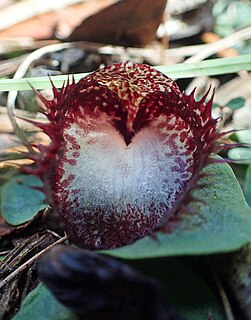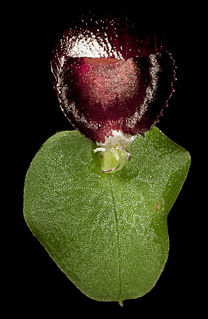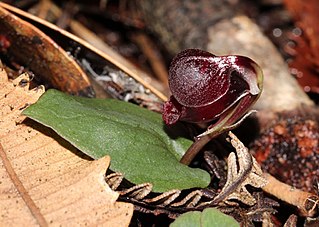
Corybas aconitiflorus, commonly known as the cradle orchid or spurred helmet orchid, is a species of terrestrial orchid endemic to eastern Australia, occurring from south-east Queensland to Tasmania. The small flowers have a hooded appearance as the uppermost sepal hides most of the rest of the flower. It is the type species of the genus Corybas.

Corybas hispidus, commonly known as the bristly helmet orchid, is a species of orchid endemic to eastern Australia. It is distinguished from other helmet orchids by its autumn to winter flowering period, and by its labellum, which has a bristly-hairy, creamy-white centre and is deeply notched along its top edge.
Corybas globulus is a species of helmet orchid endemic to a small area of the New England Tableland in northern New South Wales. It is a relatively small orchid with a bright green, heart-shaped leaf and a bulbous, dark reddish purple flower.

Corybas acuminatus, commonly known as the dancing spider orchid or helmet flower, is a species of terrestrial orchid endemic to New Zealand. It has a triangular, sharply pointed leaf and a small translucent, greenish-white flower with purple markings and with very long sepals. It is found on both the main islands of New Zealand and also some of the off-shore islands.

Corybas barbarae, commonly known as fairy lanterns, is a species of terrestrial orchid endemic to eastern Australia including Lord Howe Island. It has a single dark green or reddish green, heart-shaped leaf and a small sparkling white or pinkish flower with an inflated dorsal sepal obscuring its hairy labellum.
Corybas cerasinus, commonly known as the red helmet orchid, is a species of terrestrial orchid endemic to tropical north Queensland. It has a single bluish green, heart-shaped leaf and a cherry red to dark maroon flower with its curved dorsal sepal obscuring its labellum which has an upturned tip.

Corybas cheesemanii, commonly known as Cheesemans spider orchid or spurred helmet orchid, is a species of terrestrial orchid endemic to New Zealand. It is a small orchid with a single pale green, heart-shaped leaf and usually only a single flower variously coloured from maroon to completely white. It usually grows in deep shade, often in deep leaf litter and flowers in autumn and winter.
Corybas dentatus, commonly known as the Lofty Ranges helmet orchid, is a species of terrestrial orchid endemic to South Australia. It has a more or less round leaf and a single purplish and green flower. It is only known from two locations and is listed as "vulnerable" under the Environment Protection and Biodiversity Conservation Act.

Corybas despectans, commonly known as the tiny helmet orchid or sandhill helmet orchid is a species of terrestrial orchid endemic to southern Australia. It has round or heart-shaped leaf and a tiny reddish purple flower. Unlike many others in the genus, the dorsal sepal does not cover the labellum. It is similar to C. incurvus but the flowers are smaller.

Corybas diemenicus, commonly known as the stately helmet orchid or veined helmet orchid, is a species of terrestrial orchid endemic to south-eastern Australia. It has round or heart-shaped leaf and a reddish purple flower with a central white patch.
Corybas expansus, commonly known as the flared helmet orchid, is a species of terrestrial orchid endemic to South Australia. It has a heart-shaped to more or less round leaf and a single purplish flower with greenish or transparent areas. It is a vulnerable species, found in near-coastal sand and leaf litter.

Corybas fimbriatus, commonly known as the fringed helmet orchid, is a species of terrestrial orchid endemic to eastern Australia. It has a broad egg-shaped to round leaf and a dark reddish purple to crimson flower with translucent patches. It is similar to C. hispidus but its labellum lacks a creamy-white centre and is not covered with bristly hairs.
Corybas fordhamii, commonly known as the banded helmet orchid or swamp helmet orchid, is a species of terrestrial orchid endemic to south-eastern Australia. It has an egg-shaped to heart-shaped leaf and a reddish to reddish purple flower which leans forward. It is similar to C. unguiculatis which does not grow in swamps and has a different labellum.

Corybas incurvus, commonly known as the slaty helmet orchid, is a species of terrestrial orchid endemic to south-eastern Australia. It has a broad egg-shaped to heart-shaped leaf and a dark purple flower with a white patch in the middle.
Corybas × miscellus, commonly known as the hybrid helmet orchid, is a hybrid species of terrestrial orchid endemic to South Australia and a very small area in far western Victoria. It has a heart-shaped to more or less round leaf and a single reddish purple flower with greyish translucent areas. It is a natural hybrid between C. diemenicus and C. incurvus and shares the characteristics of the parent species.
Corybas montanus, commonly known as the montane helmet orchid, is a species of terrestrial orchid endemic to Queensland. It forms small colonies and has single heart-shaped to round leaf and a reddish, self-pollinating flower with a curved dorsal sepal. It is only known from the Mount Barney National Park in south-east Queensland.

Corybas pruinosus, commonly known as the toothed helmet orchid, is a species of terrestrial orchid endemic to New South Wales. It grows in moist forests and has a single round or heart-shaped leaf and a relatively small, translucent grey flower with dark red markings.

Corybas recurvus, commonly known as the western helmet orchid or common helmet is a species of terrestrial orchid endemic to Western Australia. It has round or heart-shaped leaf and a dark reddish purple or purplish black flower. It is widespread and common between Bunbury and Albany.

Corybas undulatus, commonly known as tailed helmet orchid, is a species of terrestrial orchid endemic to eastern Australia. It has a single leaf and a single translucent grey flower with reddish markings, and a labellum with a bristly surface, fine teeth on the edge and a small tail on the tip.

Corybas unguiculatus, commonly known as the small helmet orchid or pelicans, is a species of terrestrial orchid endemic to south-eastern Australia. It is a widespread, sometimes common but small orchid with a single leaf and a single reddish purple to reddish black flower.












